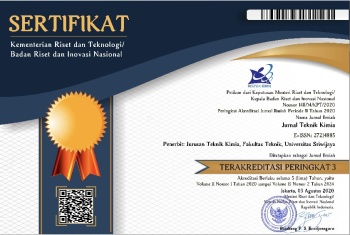Pengaruh Penambahan Serbuk Alumina (Al2O3) pada Komposit Serat Kayu Jati Bermatriks Polipropilena
Abstract
Limbah serbuk kayu jati hasil penggergajian kayu merupakan salah satu bahan alami yang belum termanfaatkan dengan baik. Penanganan limbah serbuk kayu jati yang tidak tepat dapat merusak lingkungan. Pemanfaatan serat atau partikel alami merupakan upaya alternatif bahan ramah lingkungan untuk menggantikan serat sintetis. Dalam aplikasi komponen otomotif membutuhkan bahan yang ringan seperti polipropilena tetapi dengan sifat mekanik yang lebih tinggi, sehingga pengembangan polipropilena sebagai matriks dalam komposit perlu dilakukan. Komposit pada umumnya terdiri atas matriks dari bahan polimer dan pengisi berupa serat atau partikel. Penggunaan serbuk kayu jati dapat menjadi partikel pengisi komposit. Penambahan filler dalam komposit diharapkan dapat meningkatkan sifat dari komposit dan mengurangi biaya produksi. Aluminium oksida (Al2O3) dapat dimanfaatkan sebagai filler karena memiliki sifat kekerasan dan stabilitas termal yang baik. Tujuan penelitian ini adalah mengetahui pengaruh variasi penambahan aluminium oksida terhadap kuat tarik, stabilitas termal, kekerasan, dan morfologi komposit polipropilena/serbuk kayu jati. Variabel penelitian ini adalah variasi komposisi aluminium oksida sebesar 1, 3, 5, dan 10 %berat dengan komposisi polipropilena/serbuk kayu jati sebesar 80:20 %berat. Metode pembuatan komposit yang digunakan adalah metode compression molding dengan mesin manual forming. Hasil penelitian menunjukkan bahwa variasi komposisi aluminium oksida pada komposit polipropilena/serbuk kayu jati 80:20 %berat tidak mempengaruhi kekuatan tarik, tetapi meningkatkan nilai temperatur transisi kaca (Tg) dengan nilai tertinggi 43,2 °C dan meningkatkan kekerasan dengan nilai kekerasan tertinggi 88 Shore D pada komposisi Al2O3 10 %berat.
References
Ardiansyah, M. R. (2016). Experimental study of biocomposite pellet variation in composition (polypropylene, rice husk and Maleic Anhydride PP) to thermal properties & surface structure as plastic alternatif material. Sepuluh Nopember Institute of Technology.
Arif, S., Irawan, D., & Jainudin, M. (2019). Karakteristik Sifat Mekanis Disk Pad Komposit Serbuk Kayu Jati – Polyester. Seminar Nasional Teknologi Dan Rekayasa, 169–176.
Aynalem, G. F., & Sirahbizu, B. (2021). Effect of Al2O3 on the tensile and impact strength of flax/unsaturated polyester composite with emphasis on automobile body applications. Advances in Materials Science and Engineering, 2021. https://doi.org/10.1155/2021/6641029
Balasubramanian, M. (2013). Composite Materials and Processing. Composite Materials and Processing. https://doi.org/10.1201/b15551
Darmansyah, Novaringga, A., Damaru, R., & Ginting, S. (2021). Vinyl Ester Composite Synthesis Reinforced with Banana Tree Fiber with the Nanofiller Addition. Indonesian Journal Of Chemical Dcience, 10(2), 1–6.
Hasyim, U. H., Yansah, N. A., & Nuris, M. F. (2018). Modifikasi Sifat Kimia Serbuk Tempurung Kelapa (STK) sebagai Matriks Komposit Serat Alam dengan Perbandingan Alkalisasi Naoh dan KOH. Seminar Nasional Sains Dan Teknologi 2018, 15, 1–7.
Holbery, J., & Houston, D. (2006). Natural-fiber-reinforced polymer composites in automotive applications. Energy Science and Technology Departmen, 58(11), 80–86. https://doi.org/10.1007/s11837-006-0234-2
Huang, A., Yu, P., Jing, X., Mi, H. Y., Geng, L. H., Chen, B. Y., & Peng, X. F. (2016). The Effect of talc on the mechanical, crystallization and foaming properties of poly(lactic acid). Journal of Macromolecular Science, Part B: Physics, 55(9), 908–924. https://doi.org/10.1080/00222348.2016.1217186
Jiang, W., Jin, F. L., & Park, S. J. (2012). Thermo-mechanical behaviors of epoxy resins reinforced with nano-Al2O3 particles. Journal of Industrial and Engineering Chemistry, 18(2), 594–596. https://doi.org/10.1016/j.jiec.2011.11.140
Kader, E. E., Abed, A. M., & Al-Shammari, M. A. (2020). Al2o3 reinforcement effect on structural properties of epoxy polysulfide copolymer. Journal of Mechanical Engineering Research and Developments, 43(4), 320–328.
Kadhim, M. J. H., Al-dabbadh, B. M., & Kadhim, H. J. (2022). Study of the Mechanical Properties of Polypropylene Composites Reinforced with Alumina Microfibers. Eurasian Journal of Physics, Chemistry and Mathematics, 7, 35–41.
Latief, F. H., Chafidz, A., Junaedi, H., Alfozan, A., & Khan, R. (2019). Effect of alumina contents on the physicomechanical properties of alumina (Al2O3) reinforced polyester composites. Advances in Polymer Technology, 2019, 1–10. https://doi.org/10.1155/2019/5173537
Li, B., Li, R., & Xie, Y. (2017). Properties and effect of preparation method of thermally conductive polypropylene/aluminum oxide composite. Journal of Materials Science, 52(5), 2524–2533. https://doi.org/10.1007/s10853-016-0546-8
Medupin, R., Abubakre, O., Ukoba, K., & Imoisili, P. (2013). Mechanical Properties of Wood Waste Reinforced Polymer Matrix Composites. American Chemical Science Journal, 3(4), 507–513. https://doi.org/10.9734/acsj/2013/5637
Nayak, R. K., Dash, A., & Ray, B. C. (2014). Effect of Epoxy Modifiers (Al 2 O 3 /SiO 2 /TiO 2 ) on Mechanical Performance of epoxy/glass Fiber Hybrid Composites. Procedia Materials Science, 6(Icmpc), 1359–1364. https://doi.org/10.1016/j.mspro.2014.07.115
Nisa, K. S., Melyna, E., & Samida, M. R. M. (2022). Sintesis Biokomposit Serat Sabut Kelapa dan Resin Poliester dengan Alkalisasi KOH. Rekayasa, 15(3), 354–361.
Panaitescu, D., Ciuprina, F., Iorga, M., Frone, A., Radovici, C., Ghiurea, M., Sever, S., & Plesa, I. (2011). Effect of SiO2 and Al2O3 nanofillers on polyethylene properties. Wiley Online Library. https://doi.org/10.1002/app
Said, M., Mentari, E. C., Ardilla, D., Masura, M. D., & Nasution, A. (2021). Studi suhu transisi gelas produk pegcangkokak anhidrida maleat pada karet alam siklis: metode differential scanning calorimetry. Jurnal Kimia Mulawarman, 19, 45–50.
Verma, C. S., Sharma, N. K., Chariar, V. M., Maheshwari, S., & Hada, M. K. (2014). Comparative Study of Mechanical Properties of Bamboo Laminae and their Laminates with Woods and Wood Based Composites. Composites Part B: Engineering, 60, 523–530. https://doi.org/10.1016/j.compositesb.2013.12.061
Zhang, X., Xia, X., You, H., Wada, T., Chammingkwan, P., Thakur, A., & Taniike, T. (2020). Design of continuous segregated polypropylene/Al2O3 nanocomposites and impact of controlled Al2O3 distribution on thermal conductivity. Composites Part A: Applied Science and Manufacturing, 131(February), 105825. https://doi.org/10.1016/j.compositesa.2020.105825

This work is licensed under a Creative Commons Attribution 4.0 International License.










